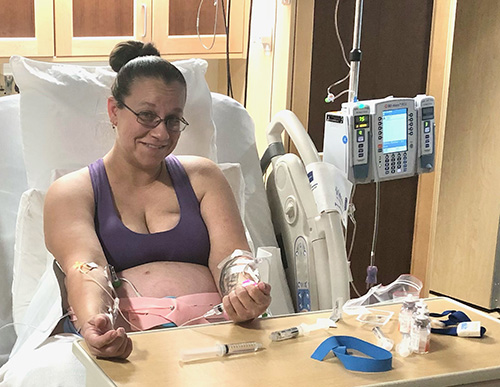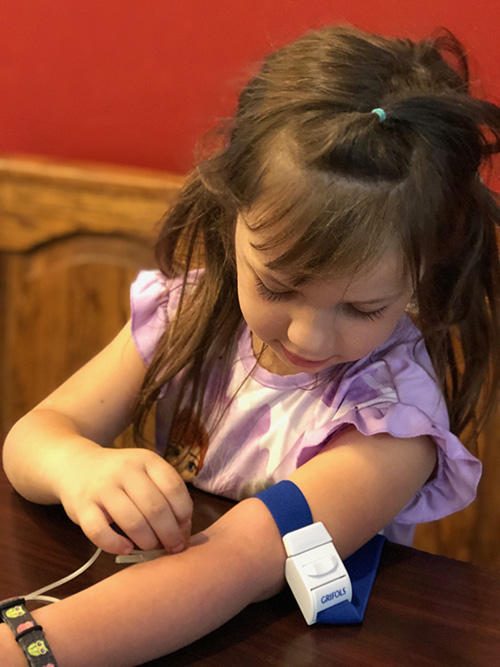One Tough Mother
Mother of seven kids, all diagnosed with von Willebrand disease (VWD), Robin herself has only been clinically diagnosed with the disorder on the basis of her symptoms; blood panels and genetic testing have never shown the disease. She has suffered problematic pregnancies, life-threatening deliveries, and serious, persistent vaginal and rectal bleeding as an adult. Until her most recent pregnancy she had never been given a prescription to control bleeding. She had over time, however, seen all of her children diagnosed and treated with various medications – Amicar®, Humate-P®, Stimate®, tranexamic acid, and finally, after persistent advocacy with her hematologist, wilate®.*
“I prefer that my kids use wilate. We have had issues with other treatments. Stimate wasn’t always efficient at resolving bleeds. Tranexamic acid gave the kids headaches. They think Amicar tastes disgusting. Our first factor product was Humate-P then wilate. Although they don’t love getting poked with needles, I think that wilate is the best option for my family. I have fought to get prescriptions for wilate. It’s been much easier now that current batches of Stimate have been recalled. I have also fought to keep a dose of wilate on hand at home for every one of us in case of emergencies. Protecting my kids is a ‘no-brainer’.”
* Amicar® is a registered trademark of Clover Pharmaceuticals Corp. Humate-P® is a registered trademark of CSL Behring GmbH. Stimate® is a registered trademark of Ferring Pharmaceuticals.
A Matter of Life and Death

Eight weeks into pregnancy with her seventh child, Robin was offered Stimate to control her severe vaginal and rectal bleeding. “I knew that a side effect of Stimate is fluid retention so I asked my doctor to try wilate instead. I had learned about it from another woman with VWD, like me, who also had passed it along to all of her kids. And I had done my research. Now this doctor was unaware of wilate, but based on my experience with my kids and my research, I knew a lot. So I explained that unlike Humate-P, wilate has a balanced ratio of von Willebrand Factor and Factor 8.”
According to Robin, choosing factor therapy can be a difficult decision. There are the needles, it can take time to figure out correct dosing and dosing intervals, and infusing can be time-consuming. But in her view it all boils down to quality of life. “I would so much rather deal with factor therapy than return to dealing with my symptoms from prior treatments. For me, it really is a matter of physical and emotional life and death. I can’t go back to the life I had before factor.”
Hard-Fought Battles
Robin has seen that for many people like her with a clinical diagnosis of VWD, it can be hard to be taken seriously. “It’s common to be discredited and discounted when talking about bleeds and bruising. Lobbying for what you need and standing up for yourself and your family can be a battle. But it’s worth it.” A fearless trailblazer, Robin wants to lay the groundwork for others, so that those who follow will have an easier time self-advocating and collaborating in treatment decisions. She is well on her way.
Child’s Play

“One of the surprising things to me about factor therapy is that it’s not as hard as you think it will be.” For Robin, it is key to listen to your body and understand what it’s telling you. She has spent a lot of time doing just that, taking charge and working with her hematologist to calibrate her dosing to her body’s needs, especially after contracting COVID-19. She has also made the effort to familiarize her kids and normalize infusing so that they won’t be afraid of it.
She’s been successful. Her kids play-act infusing, and when her six-year-old had an injury requiring infusion, she announced to the visiting nurse that she wanted to do the infusion herself. And she did! “I think anyone trying factor will be pleasantly surprised how easy it is to manage and how well the body responds. It may not be child’s play, but it’s not so very difficult either.”
